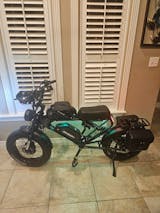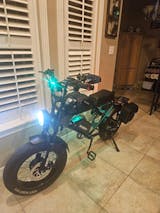Table of Contents
Fat tires ebikes quickly became popular because of their ability to pass through any terrain, from the streets of the city to the field trails. Their wide tires offer excellent adhesion, stability and comfort; Creating these bikes ideal choices for commuting and adventure riders.
As with any electric bikes, there may be performance problems over time. The riders may notice that their batteries are released quickly, their engine does not accelerate smoothly or controls of the driver; Ignoring such problems could lead to poor efficiency and costly repair.
Problems with eliminating problems on a fat tire ebike tire is necessary to ensure smooth driving and extend its life. Common problem areas include batteries, engines, drivers, tires and wiring - understanding the potential points of failure of these components can help identify problems before they become the main obstacles.
Common Performance Issues and Their Causes
Even top fat tire ebikes may experience performance issues from time to time. Gaining an understanding of symptoms, causes, and quick fixes is key for keeping your ebike running smoothly - here are the most commonly occurring issues along with solutions.
A. Battery Issues
- Symptoms: Battery like draining too quickly, e-bike does not turn on as expected or producing low power because it hangs heavy on its battery indicates battery issues. If your ebike is running out of power too quickly or reaching hills or running out of power, then the battery may not produce enough.
- Possible Causes: This could be caused by loose connections, an aging battery or a malfunctioning charger. Over time lithium-ion batteries degrade, becoming less effective at holding their charge and intermittent power losses may occur as a result. Poor connection between battery and controller could also contribute.
- Quick Fix: For battery terminals to function optimally, they should be free from dirt or corrosion, so regular inspection and cleaning may be necessary. Use a multimeter to check voltage output compared with expected output; replacement may be necessary in severe cases.
B. Motor Issues
- Symptoms: If your fat tire ebike is not accelerating properly or has suddenly lost power during a ride, its motor could be the source of its problem.
- Possible Causes: Overheating, damaged wiring and loose motor connections may be to blame for performance failures on an ebike. Furthermore, overloading or riding in extreme conditions can put undue stress on its motor and put additional strain on its circuitry.
- Quick Fix: Check all connections of the motor wiring to ensure all connections are tight, while checking for signs of burnt wires or excessive heat. If necessary, reset controller settings to restore optimal performance.
C. Controller and Wiring Problems
- Symptoms: However if you notice your ebike losing intermittent power or speed fluctuates that make no sense and do not sound like something that is wrong with the eBike itself, chances are the controller or the wiring is the issue.
- Possible Causes: If there is any water damage, loose controller wires or defective sensors, then power flow will be impeded. Corrosion due to moisture exposure can corrode electrical components and causes poor performance as well.
- Quick Fix: Look inside the controller case at the wiring to ensure that burnt or disconnected cables were replaced, the cables secured, and damaged components replaced.
D. Tire and Braking Issues
- Symptoms: If your fat tire ebike seems slow or handles poorly, or has an increased rolling resistance, the problem could lie within its tires or brakes.
- Possible Causes: Low tire pressure, worn-out brake pads or misalignment can have a direct effect on performance. Underinflated fat tires also increase rolling resistance which makes it harder for motors to keep speed.
- Shortcut: Greater traction and efficiency of your fat tire ebike is achieved by inflating its tires to their recommended PSI while ensuring proper brake pad inspection for wear and aligning the wheels to reduce drag.
Performs analysis of your fat tire ebike performance problems to achieve ongoing peak operating condition for an effortless riding.
Step-by-Step Troubleshooting Guide
If your fat tire ebike is underperforming, use this step-by-step troubleshooting guide to quickly diagnose and address the issue. This document covers essential checks that can restore performance to restore efficiency quickly.
1. Assess Battery Health
The battery is your main power source, so any weakness or failings could wreak havoc with performance. Start by testing its voltage with a multimeter; if its reading falls short of expectations, this indicates a weak or failing battery may need charging or replacement. Inspect terminals for dirt or corrosion which can hinder power flow; tighten connections as loose wires could result in intermittent power losses.
2. Examine the Motor & Wires
A motor is responsible for propulsion, and any loose or damaged wires could impede its proper function. Examine the wiring harness for frayed or burnt wires which could indicate overheating; secure any disconnected ones as soon as you spot them; allow any hot motors to cool before testing them again.
3. Test the Controller
The controller regulates power distribution to all components on an electric bike. If your fat tire ebike is experiencing speed fluctuations or random shut-offs, resetting its settings might help. Also check for signs of overheating as excessive heat can decrease performance significantly.
4. Examine Tire Condition
Underinflated fat tires can increase rolling resistance, making it harder for an ebike to maintain speed. Use a pressure gauge to check that they meet their recommended PSI value; additionally check for punctures or uneven wear which could interfere with handling.
5. Track Performance Changes
After each fix, take your fat tire ebike for a test ride to observe any changes to acceleration, speed and battery performance. If issues continue, repeat these checks or seek professional assistance for assistance.
Following this troubleshooting guide will allow you to recognize and address common performance issues, providing a smoother and more efficient ride.
Preventative Maintenance Tips
Your electric bike with large tires requires consistent proper care to maintain its optimal condition. The steps mentioned for preventive maintenance enable your equipment to reach longer operational periods while managing performance problems swiftly and effectively.
1. Proper Battery Charging and Storage
Your fat tire ebike's battery is its cornerstone component, and should always be charged regularly at 30-40% capacity to prevent deep discharge which shortens lifespan. If not using for extended periods, store the battery at 50% charge level in a cool dry environment away from extreme temperatures that may degrade its cells over time.
2. Clean and Lubricate Moving Parts
Dirt, dust and moisture can quickly wear down essential moving parts such as the chain, derailleur and gears of an ebike. Regularly remove buildup using a soft brush and degreaser with degreasers specifically made for cleaning electronic bikes; additionally use high-grade lubricants on chain and drivetrain components to promote smooth operation while decreasing friction; this way your fat tire ebike experiences less resistance, improving overall performance and efficiency.
3. Store Your Ebike Dry
Moisture being a killer of electronic components can lead to wiring troubles and also to a faulty controller. For the best performance, store your fat tire ebike in dryer, indoor or under cover conditions away from rain, snow, also stand the chance of accidentally exposing it to moisture. If your ebike gets wet by accident, dry it as soon as it is possible in order to prevent corrosion damage and you can safely ride your fat tire ebike!
Conclusion
In summary, troubleshooting problems with common problems with fat tire ebike performance -for example, battery problems, engine disorders, and controller problems are often solved by some basic steps, such as connecting connection and testing components. Regular maintenance, such as proper battery charging, regular cleaning of moving parts and storage Ebike in a dry environment will also help alleviate many of these problems of discovery.
Calling a professional technician remains your best action when issues persist after attempting your troubleshooting steps. The experts will give you a thorough diagnosis while protecting the overall condition of your fat tire ebike. Regular maintenance of fat tires will help save money on costly repairs while ensuring smooth operation.
FAQs
1. How often should I charge my fat tire ebike battery?
It is best to charge your fat tire ebike battery at a 30-40% capacity level to maintain battery health and extend product lifespan. The storage process requires you to first charge the battery to fifty percent capacity and then store it in a dry and cold environment.
2. What causes my fat tire ebike to lose power?
Power loss could be caused by problems with battery, engine, controller or cabling - for example, free connection, degraded batteries or overheated engines are possible causes. If there is an intermittent loss of power, it would also be wise to check the controller for potential wiring disorders or damaged sensors in its circuits.
3. Can I ride my fat tire ebike in the rain?
Most fat tire ebikes are water resistant, but not fully waterproof; While light rain can still be safe for driving, extended exposure to wet conditions could damage electronic components and increase the risk of corrosion. After riding in wet conditions, be sure to immediately dry the ebike and store it somewhere dry to prevent further development of corrosion problems.




















